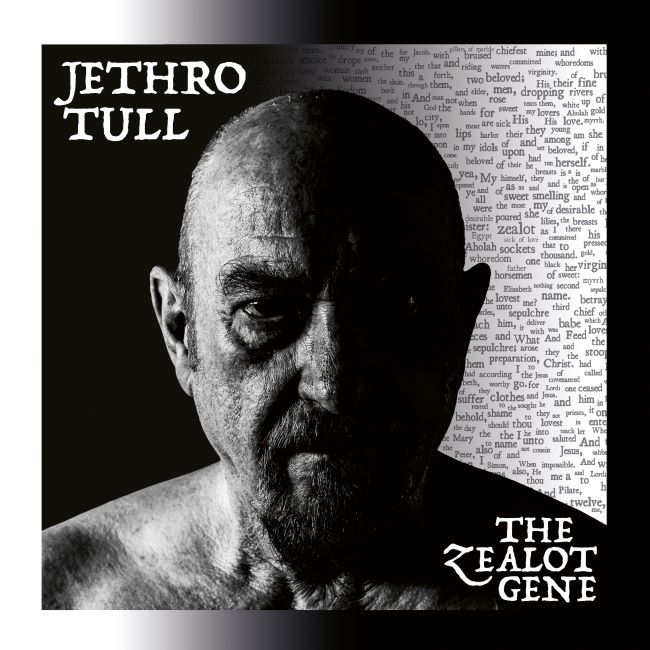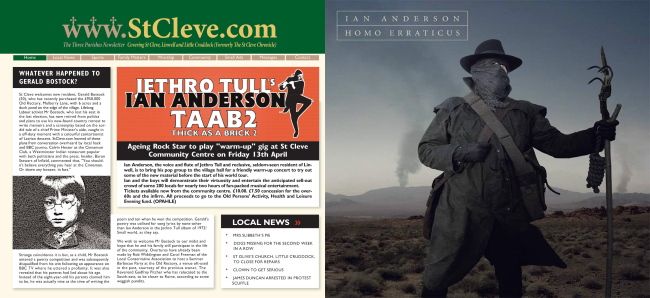I. Solo Schismaticus
Back in 2011, Ian Anderson apparently told Jethro Tull drummer Doane Perry and guitarist Martin Barre that their services were no longer needed and then put the band on indefinite hiatus. Barre contends that he and Perry were blindsided by the news while Anderson maintains he was diplomatic about the parting of the ways. Setting out as a solo artist, Anderson retained the services of keyboardist/ accordionist John O’Hara and bass player David Goodier who had joined Tull in 2006 after Andrew Giddings and Jonathan Noyce departed the band.
Martin Barre's firing hit Tull fandom the hardest. Barre had been in Jethro Tull since late 1968 and was instrumental in crafting the band’s sound over the years with his jack-of-all-trades playing style that was sometimes bluesy and sometimes something completely different. (I am unsure how to describe his playing on "Magus Perde", for example.) Anderson has noted that he owns the legal entity
that is Jethro Tull, Inc. "As far as the name Jethro Tull in any musical context is concerned, for
many, many years, my company has owned that trademark and copyright in
the name". It being his company, I presume Barre was merely an employee of said entity. Hence,
Anderson’s ability to just hand the long-time guitarist his walking papers.
While I love listening to music, discussing it and writing about
it, the business side is largely a mystery to me.
Prior to Tull’s demise, Anderson had rounded out his solo band
with Scott Hammond on drums, Florian Opahle on guitar, and Ryan O’Donnell to
add additional vocals. They spent the autumn of 2011 recording Thick As a Brick
2 which was released in April of the following year. Two years later this
line-up recorded Homo Erraticus which came out in April 2014.
I say this as Tull spent its final decade or so essentially dead creatively, a prog zombie lumbering in 4/4 towards those final cymbal crashes of "Locomotive Breath". After touring in support of 1999’s J-Tull Dot Com, precious little new material
emerged. The Jethro Tull Christmas Album was released in 2003 but
featured only a few new tunes scattered amongst inferior re-recordings of Tull seasonal classics. Setlists of live shows had precious little variation and featured mainly older
material with songs from their last couple albums, the aforementioned Dot
Com and 1995’s Roots to Branches, largely ignored. Concerts were
dominated by songs that predated Anderson’s throat problems of 1985 and so you
had Ian Anderson trying to adapt the twisty, soaring
vocals of his 20-something self to his 50-something vocal chords. Some songs made the transition well while others suffered from a lack of vocal punch.
As the aughts progressed, new songs would trickle in here
and there. In 2007 “The Donkey and the Drum” began to be played as did “Birnam
Wood to Dunsinane”. Neither song would get recorded, to my knowledge. In 2009, “Tea
With the Princess” and “A Change of Horses” appeared. The former would
disappear into obscurity while the latter would end up on TAAB2.
Starting in 2010, Anderson would move most of the new songs
over to his solo shows leaving Tull to mindlessly plunder its back catalogue, although “A
Change of Horses” was played by the band nearly to the bitter end. Solo gigs saw the introduction
of a couple more new songs, “Adrift and Dumbfounded” and “That F***ing Tune”,
a.k.a. – “Overture”. Both would end up on TAAB2 with the latter being
retitled “Pebbles Instrumental”.
My gripe is their mixes. I find these album to have something of a flat sound with little punch to my ears and the songs often times
could use a little grittiness. The music sounds too clean. Also, there is a bit too much space between the instruments giving an ambience that feels a little too ordered, a little too calculated. What’s so odd about
this is that Anderson was having Steve Wilson remix most of Tull’s back
catalogue and praised his sonic arranging abilities to add to old
Tull some of the qualities that are missing here. Probably because of this, Florian Opahle’s
guitar never really comes alive for me. It deserved to be as brash as Martin
Barre’s playing.
As I said, I like TAAB2 and Homo Erraticus. They were not
listened to once and promptly set on my shelf to gather dust and be forgotten.
And so I was happy last year to hear Ian Anderson announce that he was releasing
new music. I was shocked when he said it was to be a Jethro Tull album.
Dumbfounded, you might say. Anderson had, after all, declared, "without Martin
Barre, there would be no Jethro Tull."
My first taste of the new album, The Zealot Gene, came in November when a video for “Shoshana Sleeping” went live on YouTube. With a flute melody that is one of the catchiest of Anderson’s career, I took to it instantly.
The day came and the full album became available on YouTube. Before long I caught wind of many positive reviews, some of which favorably compared it to Aqualung. Tull’s Twitter account was soon thanking fans for the album’s high chart positions in multiple countries. I tried ordering it from my local record shop - shameless plug ahead - MadCity Music, but they were unable to get their hands on a copy. (!!) I guess it was doing well. The band’s website was sold out too. Luckily I found a copy at the record label’s site.
Somewhere along the way Anderson made his peace with the Jethro Tull moniker. In an interview included with
While the Bible provided inspiration for all of the songs, some of them leave the Biblical references behind and merely share thematic material. Just like
 |
| (It looks like IA went the Phil Collins route for the cover.) |
The album begins the with a deep, ominous sounding drone and a brief flourish of synth strings. Once you put together the lyrics, it's hard not to hear that drone as the rumble of a B-29 bomber, more specifically, the Enola Gay. The song, "Mrs. Tibbets", is about the atomic bomb dropped on Hiroshima. The plane was named after pilot Paul Tibbets' mother. A few verses of Genesis are noted as the inspiration and they, of course, tell of the destruction of Sodom and Gomorrah.
"Mrs. Tibbets" is, to my mind, a sequel to "Heavy Metals" from Homo Erraticus. That song noted humanity's tendency to build ever deadlier weapons to express our anger culminating in the atomic bomb. The band is in fine form here with Hammond and Goodier laying down an insistent beat for Anderson's tale. O'Hara adds keyboards of all sorts as Opahle's muscular guitar adds an edge in contrast to the dramatic synths. In classic Tull style, flute drags the songs from tempo to tempo, verse to bridge, and back again.
This is followed by "Jacob's Tales" which delves into sibling rivalry a la Jacob and Esau. This is more of an acoustic affair with Anderson's guitar and a long lost harmonica providing the backdrop. When was the last time there was any harmonica on a Tull album? Too Old To Rock’n’Roll: Too Young to Die!? A little mandolin briefly embellishes the spare arrangement.
As I noted above, some reviews of this album made comparisons to Aqualung and I immediately thought of "My God" upon hearing "Mine Is the Mountain" with its opening piano notes that are somber and slightly threatening, just like its cousin from 1971. There is some nice piano-flute interplay and I love how Hammond's fills intercede.
Less than two weeks before the album was released, a video for the title track appeared. It reminded me of something philospher E.M. Cioran once wrote: "I feel safer with a Pyrrho than with a Saint Paul, for a jesting wisdom is gentler than an unbridled sanctity." Opahle has some crunchy riffs in there which sound heavier than anything on TAAB2 or Home Erraticus. They're warranted as Anderson warns against figures like Donald Trump, demagogues who pander to hate and get people at each other's throats both on- and offline.
"Shoshana Sleeping" finds erotic inspiration in the Song of Solomon for such evocative lines as "Fingers tremble, trace the line/from nape to sacrum down the spine". Hammond shines here as his solo drums open the song before he starts pounding out the beat. I love that he hits an open hi-hat as it gives the song something of a ragged, slightly out of control feel. Opahle's playing is admirably restrained as Anderson sets the upbeat tone with one of his best flute melodies. Full stop. This is classic Tull.
This is followed up by another single, "Sad City Sisters", which was released on YouTube in what is surely of one the most unsettling, if not downright disturbing, videos to ever feature a hand puppet. An acoustic ditty with yet another great melody, it features the return of the pennywhistle, which I think has been M.I.A. since 1988. It is another one of those observational songs from Anderson, concerning the young and their hedonistic ways. Some tasteful accordion here chases the flute and the mandolin returns for a wonderfully folky outro.
The gentlest moments on the album are found on "Where Did Saturday Go?", with its minimal instrumentation. Mainly acoustic guitar that I found reminiscent of 1975's "Requiem" and bass, there's the obligatory flute embellishments as impressionistic lyrics evoke the preparations of Jesus' body. This is followed by the tender verses of "Three Loves, Three". The choruses pick up the pace a bit as Anderson notes the different passions aroused by the different kinds of love. Another wonderful acoustic piece.
The Zealot Gene is a strong album which conclusively demonstrates that Ian Anderson is not a spent force creatively. Whether Martin Barre's absence disqualifies it as a "true" Jethro Tull album is really a dead end. This album is full of wonderfully melodic songs with the trademark Tull twists and turns. Anderson's flute seems a little less clean here and I think John O’Hara came into his own. He doesn't sound like he's struggling to carve out space for his parts but rather he is taking it as his own.
.jpg)

.jpg)
No comments:
Post a Comment